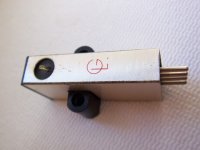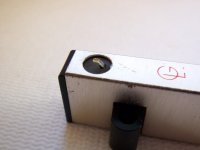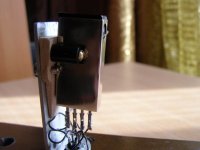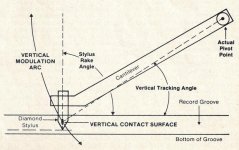I've experienced difficulties with some old phono cartridges, they do have 90 degrees VTA. Mono cartridges include: EMT OFC25, OFD25. Those were dedicated for microgroove records. The same problem with Stanton 380, it is a stereo cartridge, and perpendicular VTA seems to be improper for stereo records? Only after the whole cartridge angle was corrected for obtaining 15 degrees VTA, it's sound opened. Same story with ancient Grado GL stereo MC cart (see pictures). I'll be grateful for info about VTA standards history, especially when they switched from 90 degrees...
Attachments
Last edited:
I'm by no means an expert, and am still trying to figure things out, but I suspect it has a lot to do with stylus geometry. I know that my Ortofon Windfeld with Replicant 100 stylus (line contact) is extremely sensitive to VTA and that to sound its best the stylus has to be very close to 90 degrees to the groove surface, deviate more than a few degrees and things get nasty fast. I have two other cartridges with line contact styli, while they are also quite sensitive to VTA it is not to nearly the same degree as the Windfeld. I also have two cartridges with an elliptical stylus and they're very forgiving, but also come nowhere close to the level of performance of the two best line contact cartridges in my system.
walterwalter
As far as I know, VTA was never 90 d. It varied a lot but it was nowhere close to 90 d.
At around 1958 it was standardised at 15d, by 1975 it had gone to 20d.
See here for a good VTA history summary (1960 and on).
VTA
I like the wedge you’ve made.
Kevin
Get yourself a spherical tip. It makes precise VTA adjustment unnecessary 😀
With a DenonDL103, I can not hear any change, with a Shure M97xE VTA change becomes a bit noticeable (but I am half deaf).
Exposing the VTA myth? [English]
George
As far as I know, VTA was never 90 d. It varied a lot but it was nowhere close to 90 d.
At around 1958 it was standardised at 15d, by 1975 it had gone to 20d.
See here for a good VTA history summary (1960 and on).
VTA
I like the wedge you’ve made.
Kevin
Get yourself a spherical tip. It makes precise VTA adjustment unnecessary 😀
With a DenonDL103, I can not hear any change, with a Shure M97xE VTA change becomes a bit noticeable (but I am half deaf).
Exposing the VTA myth? [English]
George
VTA 90 degrees
Thank you. However it certainly was perpendicular with early carts, here are tech data for EMT OFD and OFC mono carts EMT pick-up's - technical data
Vertical tracking angle 90° 90° 90° 90°
Thank you. However it certainly was perpendicular with early carts, here are tech data for EMT OFD and OFC mono carts EMT pick-up's - technical data
Vertical tracking angle 90° 90° 90° 90°
walterwalter
I hesitate to bring this up after youv've slaved over that wedge, but...
If you've got $400+ usd or so burning a hole in your pocket, Dual cs5000 arms have an adjustment for setting VTA in the headshell. Check the pix, and you will see a dial mounted in the shell, facing up. Dual first used this on the Perpetuum Ebner changers(30 series) they produced after buying PE in 1972 IIRC. PE had had this feature for some time. The reason they gave for it was to deal with the change in height of a stack of records. A PE 2040(last produced before sale to Dual) is IMHO better than Dual 1229, its' contemporary equivalent. They go for less than the Dual cs5000 tables.
I hesitate to bring this up after youv've slaved over that wedge, but...
If you've got $400+ usd or so burning a hole in your pocket, Dual cs5000 arms have an adjustment for setting VTA in the headshell. Check the pix, and you will see a dial mounted in the shell, facing up. Dual first used this on the Perpetuum Ebner changers(30 series) they produced after buying PE in 1972 IIRC. PE had had this feature for some time. The reason they gave for it was to deal with the change in height of a stack of records. A PE 2040(last produced before sale to Dual) is IMHO better than Dual 1229, its' contemporary equivalent. They go for less than the Dual cs5000 tables.
walterwalter
As far as I know, VTA was never 90 d. It varied a lot but it was nowhere close to 90 d.
At around 1958 it was standardised at 15d, by 1975 it had gone to 20d.
See here for a good VTA history summary (1960 and on).
VTA
I like the wedge you’ve made.
Kevin
Get yourself a spherical tip. It makes precise VTA adjustment unnecessary 😀
With a DenonDL103, I can not hear any change, with a Shure M97xE VTA change becomes a bit noticeable (but I am half deaf).
Exposing the VTA myth? [English]
George
I hate spherical styli.. lol I owned a Zu Denon DL-103 which was an excellent cartridge at its price point, but in no sense compares to a properly set up Windfeld. (Mine is not necessarily representative at any given moment in time. 😀 )
I guess I should have referred to SRA rather than VTA, this is actually what matters. VTA has shifted over the years but SRA hasn't and is dependent to some extent on the stylus geometry.
More here: How to Use a USB Digital Microscope to set 92 Degree Stylus Rake Angle (SRA) | Analog Planet
More here: How to Use a USB Digital Microscope to set 92 Degree Stylus Rake Angle (SRA) | Analog Planet
I guess I should have referred to SRA rather than VTA, this is actually what matters. VTA has shifted over the years but SRA hasn't and is dependent
That’s correct Kevin. Thank you.
Vertical tracking angle 90° 90° 90° 90°
Walterwalter
It is more than certain that what they define as VTA of 90 d, it is actually SRA of 90d.
http://www.analogplanet.com/images/512MFVTA_article.pdf
George
Attachments
Attachments
- Status
- Not open for further replies.
- Home
- Source & Line
- Analogue Source
- Older VTA standard issues





